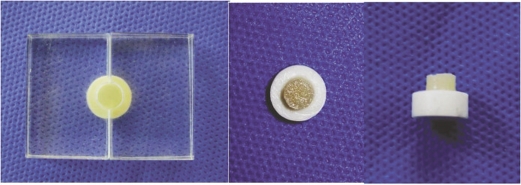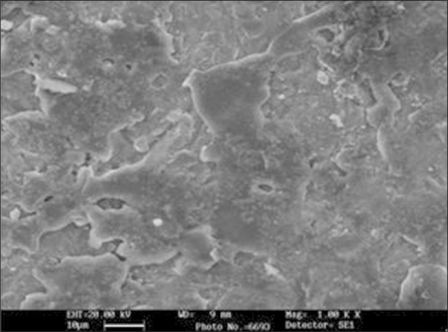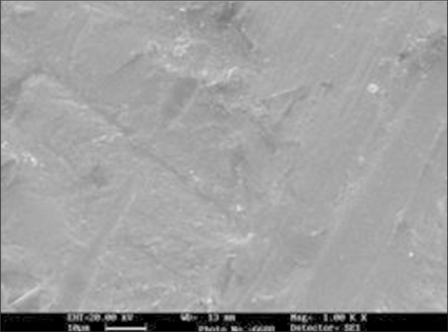J Adv Prosthodont.
2011 Dec;3(4):221-228. 10.4047/jap.2011.3.4.221.
Influence of surface modification techniques on shear bond strength between different zirconia cores and veneering ceramics
- Affiliations
-
- 1Department of Prosthodontics and Torabinejad Dental Research Center, School of Dentistry. Isfahan University of Medical Sciences, Isfahan, Iran. mosharraf@dnt.mui.ac.ir
- 2Department of Prosthodontics and Torabinejad Dental Research Center, School of Dentistry. Isfahan University of Medical Sciences, Biomaterial and Dental Material Research Group, Isfahan University of Technology, Isfahan, Iran.
- 3Department of Prosthodontics, School of Dentistry, Ahwaz University of Medical Sciences, Ahwaz, Iran.
- KMID: 2054757
- DOI: http://doi.org/10.4047/jap.2011.3.4.221
Abstract
- PURPOSE
Veneering porcelain might be delaminated from underlying zirconia-based ceramics. The aim of this study was the evaluation of the effect of different surface treatments and type of zirconia (white or colored) on shear bond strength (SBS) of zirconia core and its veneering porcelain.
MATERIALS AND METHODS
Eighty zirconia disks (40 white and 40 colored; 10 mm in diameter and 4 mm thick) were treated with three different mechanical surface conditioning methods (Sandblasting with 110 microm Al2O3 particle, grinding, sandblasting and liner application). One group had received no treatment. These disks were veneered with 3 mm thick and 5 mm diameter Cercon Ceram Kiss porcelain and SBS test was conducted (cross-head speed = 1 mm/min). Two and one way ANOVA, Tukey's HSD Past hoc, and T-test were selected to analyzed the data (alpha=0.05).
RESULTS
In this study, the factor of different types of zirconia ceramics (P=.462) had no significant effect on SBS, but the factors of different surface modification techniques (P=.005) and interaction effect (P=.018) had a significant effect on SBS. Within colored zirconia group, there were no significant differences in mean SBS among the four surface treatment subgroups (P=0.183). Within white zirconia group, "Ground group" exhibited a significantly lower SBS value than "as milled" or control (P=0.001) and liner (P=.05) groups.
CONCLUSION
Type of zirconia did not have any effect on bond strength between zirconia core and veneer ceramic. Surface treatment had different effects on the SBS of the different zirconia types and grinding dramatically decreased the SBS of white zirconia-porcelain.
Keyword
MeSH Terms
Figure
Cited by 2 articles
-
Effects of different surface treatments on the shear bond strength of veneering ceramic materials to zirconia
Adil Othman Abdullah, Yu Hui, Xudong Sun, Sarah Pollington, Fenik Kaml Muhammed, Yi Liu
J Adv Prosthodont. 2019;11(1):65-74. doi: 10.4047/jap.2019.11.1.65.The effect of zirconia surface architecturing technique on the zirconia/veneer interfacial bond strength
Soo-Bok Her, Kyoung Hun Kim, Sang Eun Park, Eun-Jin Park
J Adv Prosthodont. 2018;10(4):259-264. doi: 10.4047/jap.2018.10.4.259.
Reference
-
1. Barnfather KD, Brunton PA. Restoration of the upper dental arch using Lava all-ceramic crown and bridgework. Br Dent J. 2007; 202:731–735. PMID: 17589454.
Article2. Coli P, Karlsson S. Precision of a CAD/CAM technique for the production of zirconium dioxide copings. Int J Prosthodont. 2004; 17:577–580. PMID: 15543914.
Article3. Della Bona A, Mecholsky JJ Jr, Anusavice KJ. Fracture behavior of lithia disilicate- and leucite-based ceramics. Dent Mater. 2004; 20:956–962. PMID: 15501324.4. Casucci A, Osorio E, Osorio R, Monticelli F, Toledano M, Mazzitelli C, Ferrari M. Influence of different surface treatments on surface zirconia frameworks. J Dent. 2009; 37:891–897. PMID: 19616882.
Article5. Guazzato M, Quach L, Albakry M, Swain MV. Influence of surface and heat treatments on the flexural strength of Y-TZP dental ceramic. J Dent. 2005; 33:9–18. PMID: 15652163.
Article6. Kim HJ, Lim HP, Park YJ, Vang MS. Effect of zirconia surface treatments on the shear bond strength of veneering ceramic. J Prosthet Dent. 2011; 105:315–322. PMID: 21530757.
Article7. Bonfante EA, Coelho PG, Guess PC, Thompson VP, Silva NR. Fatigue and damage accumulation of veneer porcelain pressed on Y-TZP. J Dent. 2010; 38:318–324. PMID: 20026232.
Article8. Beuer F, Schweiger J, Eichberger M, Kappert HF, Gernet W, Edelhoff D. High-strength CAD/CAM-fabricated veneering material sintered to zirconia copings--a new fabrication mode for all-ceramic restorations. Dent Mater. 2009; 25:121–128. PMID: 18620748.9. Al-Dohan HM, Yaman P, Dennison JB, Razzoog ME, Lang BR. Shear strength of core-veneer interface in bi-layered ceramics. J Prosthet Dent. 2004; 91:349–355. PMID: 15116036.
Article10. Fischer J, Stawarczyk B, Hämmerle CH. Flexural strength of veneering ceramics for zirconia. J Dent. 2008; 36:316–321. PMID: 18339469.
Article11. Sailer I, Fehér A, Filser F, Lüthy H, Gauckler LJ, Schärer P, Franz Hämmerle CH. Prospective clinical study of zirconia posterior fixed partial dentures: 3-year follow-up. Quintessence Int. 2006; 37:685–693. PMID: 17017630.12. Komine F, Saito A, Kobayashi K, Koizuka M, Koizumi H, Matsumura H. Effect of cooling rate on shear bond strength of veneering porcelain to a zirconia ceramic material. J Oral Sci. 2010; 52:647–652. PMID: 21206169.
Article13. Fahmy NZ. Bond strength, microhardness, and core/veneer interface quality of an all-ceramic system. J Prosthodont. 2010; 19:95–102. PMID: 20040030.
Article14. Saito A, Komine F, Blatz MB, Matsumura H. A comparison of bond strength of layered veneering porcelains to zirconia and metal. J Prosthet Dent. 2010; 104:247–257. PMID: 20875529.
Article15. Vult von Steyern P, Carlson P, Nilner K. All-ceramic fixed partial dentures designed according to the DC-Zirkon technique. A 2-year clinical study. J Oral Rehabil. 2005; 32:180–187. PMID: 15707428.16. Raigrodski AJ, Chiche GJ, Potiket N, Hochstedler JL, Mohamed SE, Billiot S, Mercante DE. The efficacy of posterior three-unit zirconium-oxide-based ceramic fixed partial dental prostheses: a prospective clinical pilot study. J Prosthet Dent. 2006; 96:237–244. PMID: 17052467.
Article17. Guess PC, Kulis A, Witkowski S, Wolkewitz M, Zhang Y, Strub JR. Shear bond strengths between different zirconia cores and veneering ceramics and their susceptibility to thermocycling. Dent Mater. 2008; 24:1556–1567. PMID: 18466964.
Article18. De Jager N, Pallav P, Feilzer AJ. The influence of design parameters on the FEA-determined stress distribution in CAD-CAM produced all-ceramic dental crowns. Dent Mater. 2005; 21:242–251. PMID: 15705431.
Article19. Aboushelib MN, de Jager N, Kleverlaan CJ, Feilzer AJ. Microtensile bond strength of different components of core veneered all-ceramic restorations. Dent Mater. 2005; 21:984–991. PMID: 16085302.
Article20. Manicone PF, Rossi Iommetti P, Raffaelli L. An overview of zirconia ceramics: basic properties and clinical applications. J Dent. 2007; 35:819–826. PMID: 17825465.
Article21. Drummond JL, King TJ, Bapna MS, Koperski RD. Mechanical property evaluation of pressable restorative ceramics. Dent Mater. 2000; 16:226–233. PMID: 10762684.
Article22. Ozkurt Z, Kazazoglu E, Unal A. In vitro evaluation of shear bond strength of veneering ceramics to zirconia. Dent Mater J. 2010; 29:138–146. PMID: 20379023.23. Chaiyabutr Y, McGowan S, Phillips KM, Kois JC, Giordano RA. The effect of hydrofluoric acid surface treatment and bond strength of a zirconia veneering ceramic. J Prosthet Dent. 2008; 100:194–202. PMID: 18762031.
Article24. Fischer J, Stawarczyk B, Sailer I, Hämmerle CH. Shear bond strength between veneering ceramics and ceria-stabilized zirconia/alumina. J Prosthet Dent. 2010; 103:267–274. PMID: 20416409.
Article25. Aboushelib MN, de Jager N, Kleverlaan CJ, Feilzer AJ. Microtensile bond strength of different components of core veneered all-ceramic restorations. Dent Mater. 2005; 21:984–991. PMID: 16085302.
Article26. Aboushelib MN, Kleverlaan CJ, Feilzer AJ. Microtensile bond strength of different components of core veneered all-ceramic restorations. Part II: Zirconia veneering ceramics. Dent Mater. 2006; 22:857–863. PMID: 16376981.27. Aboushelib MN, Kleverlaan CJ, Feilzer AJ. Microtensile bond strength of different components of core veneered all-ceramic restorations. Part 3: double veneer technique. J Prosthodont. 2008; 17:9–13. PMID: 17931369.
Article28. Saito A, Komine F, Blatz MB, Matsumura H. A comparison of bond strength of layered veneering porcelains to zirconia and metal. J Prosthet Dent. 2010; 104:247–257. PMID: 20875529.
Article29. Aboushelib MN, Kleverlaan CJ, Feilzer AJ. Effect of zirconia type on its bond strength with different veneer ceramics. J Prosthodont. 2008; 17:401–408. PMID: 18355163.
Article30. Curtis AR, Wright AJ, Fleming GJ. The influence of surface modification techniques on the performance of a Y-TZP dental ceramic. J Dent. 2006; 34:195–206. PMID: 16112791.
Article31. Kosmac T, Oblak C, Jevnikar P, Funduk N, Marion L. The effect of surface grinding and sandblasting on flexural strength and reliability of Y-TZP zirconia ceramic. Dent Mater. 1999; 15:426–433. PMID: 10863444.32. Guazzato M, Proos K, Quach L, Swain MV. Strength, reliability and mode of fracture of bilayered porcelain/zirconia (Y-TZP) dental ceramics. Biomaterials. 2004; 25:5045–5052. PMID: 15109867.
Article33. Kern M, Barloi A, Yang B. Surface conditioning influences zirconia ceramic bonding. J Dent Res. 2009; 88:817–822. PMID: 19767578.
Article34. Fischer J, Grohmann P, Stawarczyk B. Effect of zirconia surface treatments on the shear strength of zirconia/veneering ceramic composites. Dent Mater J. 2008; 27:448–454. PMID: 18717175.
Article35. Al-Dohan HM, Yaman P, Dennison JB, Razzoog ME, Lang BR. Shear strength of core-veneer interface in bi-layered ceramics. J Prosthet Dent. 2004; 91:349–355. PMID: 15116036.
Article36. Fischer J, Stawarczyk B, Trottmann A, Hämmerle CH. Impact of thermal properties of veneering ceramics on the fracture load of layered Ce-TZP/A nanocomposite frameworks. Dent Mater. 2009; 25:326–330. PMID: 18804856.
Article37. Chevalier J, Deville S, Münch E, Jullian R, Lair F. Critical effect of cubic phase on aging in 3mol% yttria-stabilized zirconia ceramics for hip replacement prosthesis. Biomaterials. 2004; 25:5539–5545. PMID: 15142736.
Article38. Ardlin BI. Transformation-toughened zirconia for dental inlays, crowns and bridges: chemical stability and effect of low-temperature aging on flexural strength and surface structure. Dent Mater. 2002; 18:590–595. PMID: 12385900.
Article39. Fischer J, Stawarczyk B, Sailer I, Hämmerle CH. Shear bond strength between veneering ceramics and ceria-stabilized zirconia/alumina. J Prosthet Dent. 2010; 103:267–274. PMID: 20416409.
Article40. Tinschert J, Schulze KA, Natt G, Latzke P, Heussen N, Spiekermann H. Clinical behavior of zirconia-based fixed partial dentures made of DC-Zirkon: 3-year results. Int J Prosthodont. 2008; 21:217–222. PMID: 18548959.
- Full Text Links
- Actions
-
Cited
- CITED
-
- Close
- Share
- Similar articles
-
- Effect of surface treatmet on the shear bond strength of a zirconia core to veneering ceramic
- Shear bond strength of veneering ceramic to coping materials with different pre-surface treatments
- Shear bond strength of veneer ceramic and colored zirconia by using aqueous metal chloride solutions
- A study on the shear bond strengths of veneering ceramics to the colored zirconia core
- Shear bond strength of veneering porcelain to zirconia and metal cores




